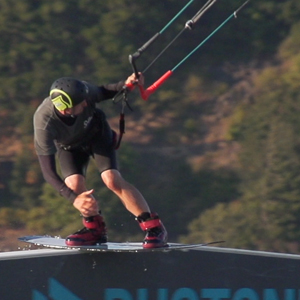How to Easily Wakefoil Behind the Boat - Hydrofoil Beginner Guide
Hydrofoiling is huge and spans several water sports. It's not hard to see why. Whatever your sport, a foil expands the conditions that you can ride in and is a fun skill set to develop.
Surfers can now ride small waves that never actually break. Kiteboarders can ride in sub-10 knots and wakeboarders can get out on the water even when it's windy and choppy out. If you think about it, there are no more excuses to not get outside and have fun in your sport.
Foiling is whatever you make of it. For some, it's kind of like wakesurfing: a chill sport you can do after your sport while hanging with friends or family. For others, it's a new discipline to push past current limits like the kiteboarders doing kiteloop-based tricks! Whatever your reason for getting into foiling, this guide will teach you how to learn the basics of the foil behind a boat.
Let's get to it.

You don't need a wakeboat to Hydrofoil
Types of Boats Needed
The good news is with modern foils, you don't necessarily need a wake boat. Having a dedicated wakeboat is awesome for rope-less wake foiling, but you can use a smaller wake.
Something like an older 90's Mastercraft would work for riding the wake. Or even a 20' Boston Whaler.
While learning with the rope, you can foil behind almost anything. A pontoon boat, a small boat with an outboard motor, even a ski. Anything that will pull you would work! It depends on what you are looking to do with the sport. Kiteboarders and surfers who want to learn can start on the boat and build their skills up fast. If you want to wakesurf, you'll need something more specific. Anything that kicks up a reasonable wake should do if you have the right wing.

Foil Equipment Needed
Again, this comes down to what your goal is with hydrofoiling. If you want to progress into the kite or the surf, learn on the wing and board you will be using in that sport. A boat, or even ski is perfect for learning the basics of your foil when conditions aren't cooperating.
Wake-Specific Wings
If you want to wakefoil behind the boat without the rope, go for a large wing or even a surf wing; something that comes onto a plane at about 11mph. A great example of this would be the the Slingshot Infinity series.
Aside from the wing, you'll want the right size mast and board.
Masts and Boards
- Short masts (24"-30") to handle chop and steep wakes
- Short fuselage for tight turns and quick pitch adjustment
- Optional - Full range of wing sizes to adapt for speed, rope-less riding, wake size, and riding style. 90-210 sq in
- Wing sizes in wake are primarily for rider weight. Use cmsq. Average adult 1200-2000cmsq wing
- 90 mm track box is the most popular type of board connection
- Most boards range in size from 3'6-5'0
- Most boards have the option to mount footstraps or hooks
- Foot hooks go along way in controlling the board and leave you freedom to fall.
- Alternatively, you could use a board that works as a wakesurfer and hydrofoil to save room on the boat.

A helmet is a good idea
Safety
You'll want all the standard gear for wakeboarding. A rope, a flotation vest, and even a helmet is not a bad idea. A good driver goes a long way too.
Set up
For first-timers, use foot hooks on the front of the board. This allows for easy falls and something to help grip the board confidently.
For the mast, you have two options.
- While learning, set the foil up as far back as possible. You can adjust your feet as you learn.
- If you're advanced, you can balance the foil to the board: put setup wings skyward on the ground. Leave track screws connected but loose so you can adjust the mast placement. Pick up the setup using the center of lift on the front wing (about 20-30% back from the leading edge). Adjust the foil position until the foil balances the board roughly level with the ground. This is a good starting point. Sadly, this method does not work as well for boards under 4', especially super light boards.
It's not too difficult to learn on the standard wake mast, around 24 inches. If you have something smaller, that's great. It's not necessary, but it does make it easier if you are struggling. If you are only focused on boat or surf, the 24-inch will be perfect. If you are a kiter, 24 is fine too. There are plenty of foilers who prefer this. If you live somewhere with a large shore break or chop, you might want to eventually progress to a larger mast. Save this for after you learn on the 24-inch.

You can foil behind almost anything with a pull
Getting started on the Water
Before attempting to foil you should have an intermediate level experience riding in a water sport. Kiteboarding, wakeboarding, even surfing will go a long way here. If you have no experience, try wakesurfing behind the boat with your board first. There are many boards that do come with a track box and fin boxes if you want a multi-purpose board.
Boat
Have the driver place the boat in gear or idle forward at a slow speed. Use this pressure to place your feet on the foil. Keep the board perpendicular to the direction of the rope.
Get into a tucked position with your shoulders in line with your knees and square up to your board and with the boat. Give the driver the signal to slowly and smoothly accelerate. The driver should maintain a speed of 9 - 12 mph. Speeds can vary depending on the board, rider and foil you are using.
Rider
As the line goes tight, let it pull you up. Keep heavy front foot pressure and stand up from the squat position. Keep both hands on the bar and keep pressure on that front foot. This will keep the foil from rising.
Ride out into the flats and away from the wake. Spend some time getting used to controlling the board on the surface of the water. Once you are comfortable, it's time to start getting some lift.
Learning to Fly
Start transferring your weight onto your back foot by shifting your hips backwards. Do this slowly and be subtle. As the board rises, slowly shift your weight forward using your hips and bring it back down. Practice coming up and down with control until you have a good feel for it. Aim for longer glides each time you come up. If you're using a smaller wing, it's going to be more reactive and might breach sooner. If you do breach, fall to the side and away from the board.

Getting Comfortable
Now that you are used to flying, practice turning and moving up and down. Try to stay up on the foil at about mid-mast. Have fun for a while. Once you are comfortable, you can practice in the wake. The second wake is smaller and easier to manage, so start here. Ride into the wake and try to feel it pushing your wing. Spend some time getting used to this. After a session or two, use a shorter rope.
Do your waterstart and cut out into the flats. Once in flight, ride into the middle of the fist wake, about 10 feet back from the boat. Do the same as before. Try to feel the wake pushing your foil. If you have a handle on it, Toss the rope and ride as long as you can.
We'll do another video specifically on riding without the rope later on.
 Ryan (Rygo) Goloversic
Ryan (Rygo) Goloversic
Many people dream of quitting their job, traveling the world and pursuing their passions. Rygo is one of those people who pulled the trigger. A few years into his career, he decided to change everything and travel as a kiteboarder, freelance videographer & writer. His mission is to share the stoke & help people put the boarding into their kiteboarding. Get outside and kite!
Producer of: Ride with Blake I Sessions I Versus I Destinations I Foil Fridays
Recent Posts
-
Waydoo EVO | Luxury Efoil Performance at a Budget Price?
eFoiling seems to be the hottest new sport, but would it surprise you to know that it's alre …21st Nov 2024 -
The Code Foils 1540S | Perfect for Beginners, Bigger Riders, and Light Wind Adventures
Foil enthusiasts, meet the Code Foils 1540S, the latest and largest addition to the po …19th Nov 2024 -
How to Work Remotely and Kiteboard in Brazil's Top Spots
You may have seen some trick tips from North and MACkite Ambassador David Fischer and wonder …19th Nov 2024




